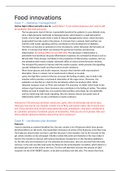Food innovations
Case 7 – diabetes management
Oat bar high in fibres and with a low GL. (which fibres? oat contains B-glucans and I want to add
the prebiotics FOS, GOS and inulin).
- The low glycaemic load of the bar is potentially beneficial for patients in a pre-diabetic state,
since a high glycaemic load leads to hyperglycaemia, which leads to a rapid demand for
insulin. Due to high insulin levels a state of rebound hypoglycaemia arises, which increases
postprandial free fatty acids in the plasma. It is known that a systemic lipid overflow can
interfere with insulin signalling and thus contributes to the development of diabetes.
- The fibres can function as prebiotics for the microbiome, which stimulates the formation of
SCFAs. It is known that SCFAs can enhance the gut barrier function and decrease
inflammation. By binding GPR41/43 and GPR 109a. The decrease in inflammation is
potentially very beneficial, because inflammatory responses are activated by kinases (such as
IKK and JNK). These kinases contribute to the production of inflammatory cytokines, but can
also phosphorylate insulin receptor substrates (IRSs) on select serine/threonine residues.
This disrupts IRS proteins to interact with the insulin receptor, which prevents the signalling
cascade initiated by insulin and thus leads to insulin resistance.
- Fibres lower glucose and insulin response, because they interfere with macronutrient
absorption, there is a slower rise in insulin levels in blood, so no peak.
- Lastly, the high fibre content of the bar increases the feeling of satiety, due to bulk in the
intestine which provides a mechanical stimulation of the vagus nerve. Moreover, the
prebiotics can function as a fuel for the microbiome which can produce SCFA. SCFAs
stimulate receptors (such as FFA2) and activates PYY promotor via HDAC which leads to the
release of gut hormones, these hormones also contribute to the feeling of satiety. The satiety
feeling can lead to weight loss, less systemic lipid overflow and ectopic fat, less lipotoxitiy
and less interfering with insulin signalling. Also less obesity induces low grade state of
inflammation which can also contribute to insulin resistance.
Hummus for T2D chick peas and tianni, lemon juice, garlic, olive oil and komijn and salt for taste.
Chick peas have low GL (no rebound). Contain a lot of fibres and protein reduce risk of muscle mass
loss. Tianny and olive olive oil have unsaturated fatty acids, antioxidants. Chick pea is considered to
be a prebiotic substance of probiotic species of lactobacillus. Chick pea are rich in protein, fibre and
other prebiotic substances Mention about if they don’t counteract!
Case 8 – cardiovascular disease
B-glucans
I want to develop an oatmeal breakfast bar, the oats contain a lot of B-glucans which have proven
beneficial effects on LDL levels. One (potential) mechanism of action of the B-glucans is the fiber trap.
The B-glucans absorb water and form a gel like-structure in the intestine. Due to the viscosity of this
gel, whole micelles can be entrapped. Micelles contain bile acids and cholesterol, the trap makes it
hard for the micelles to interact with luminal membrane transporters on the intestinal epithelium.
So, the bile salts and cholesterol can’t be absorbed by enterocytes, they are excreted from the body
via feces. In the end, less bile acids enter the blood via the enterohepatic circulation, which leads to a
decreased pool size of bile acids in the liver. The liver will therefore increase the amount of LDLR
receptors via the SCAP-SREBP2 system, to be able to produce new bile salts. This means that more





